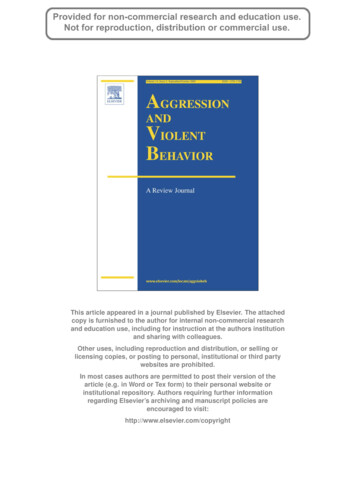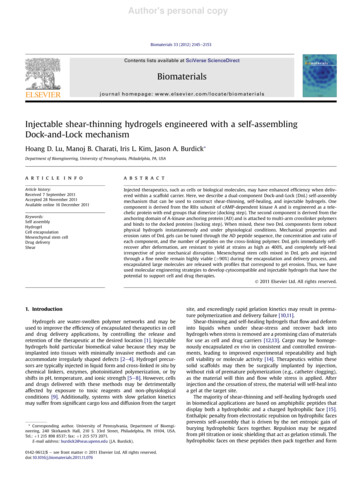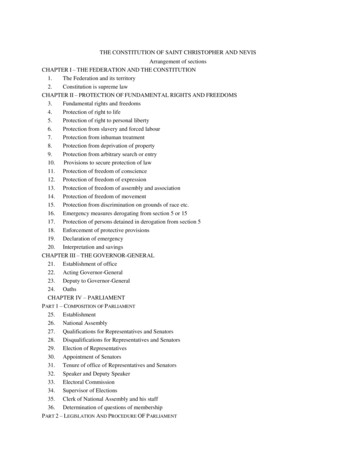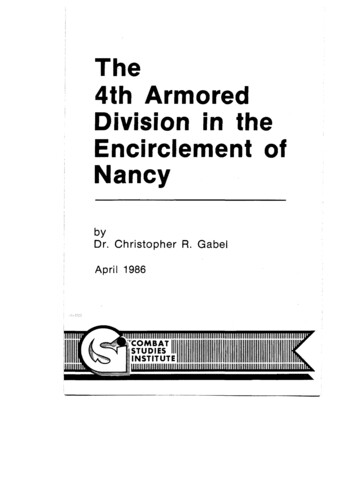
Transcription
This article appeared in a journal published by Elsevier. The attachedcopy is furnished to the author for internal non-commercial researchand education use, including for instruction at the authors institutionand sharing with colleagues.Other uses, including reproduction and distribution, or selling orlicensing copies, or posting to personal, institutional or third partywebsites are prohibited.In most cases authors are permitted to post their version of thearticle (e.g. in Word or Tex form) to their personal website orinstitutional repository. Authors requiring further informationregarding Elsevier’s archiving and manuscript policies areencouraged to visit:http://www.elsevier.com/copyright
Author's personal copyAggression and Violent Behavior 14 (2009) 286–294Contents lists available at ScienceDirectAggression and Violent BehaviorNatural born killers: The genetic origins of extreme violenceChristopher J. Ferguson a,⁎, Kevin M. Beaver babDepartment of Behavioral, Applied Sciences and Criminal Justice, Texas A&M International University, 5201 University Boulevard, Laredo, TX 78041, United StatesCollege of Criminology and Criminal Justice, Florida State University, Tallahassee, FL 32306, United Statesa r t i c l ei n f oArticle history:Received 20 January 2009Accepted 11 March 2009Available online 20 March 2009Keywords:Extreme violenceGeneticsEvolutionAggressiona b s t r a c tThe current article examines the influence of genetics and evolution on acts of extreme and criminal violenceamong human primates. Moderate aggression can function to increase an organism's reproductive success;extreme violence can place the organism at unnecessary risk. Genetic polymorphisms that have been linkedto extreme acts of violence are reviewed as is research elucidating how genetic risk and environmental stressmay interact to increase risk of extreme violence. Extreme violence is viewed as high-end variance in anevolutionarily adaptive process in which the propensity for aggression and violent behavior, in moderatedoses, has been adaptive for individual humans. 2009 Elsevier Ltd. All rights reserved.Contents1.Defining relevant terms . . . . . . . . . . . . . .2.Social science's resistance to evolution and genetics3.Genetic polymorphisms associated with violence . .4.An evolutionary approach to understanding violenceReferences . . . . . . . . . . . . . . . . . . . . . .The origin of human violence has been an issue of considerableconcern and debate for centuries (e.g., Lombroso, 1876/2006).Violence is just one outcome that has been central to the “natureversus nurture” debate. Given technical limitations and predominating scientific views, much of the research produced on violence duringthe latter 20th century focused on social, family, and cultural influences on violence. More recent research has indicated that violentbehavior has significant biological, genetic, and evolutionary origins aswell. Several studies have identified gene polymorphisms thatincrease the risk for violent behavior. Increasingly, the evolutionaryorigins of violent behavior are being explored. The current paper seeksto provide a review of what is currently known about the genetic andevolutionary origins of extreme violent behavior.1. Defining relevant termsIt is important to recognize that the terms used in the currentpaper, namely “aggression” “violence” and “extreme violence” should⁎ Corresponding author. Tel.: 1 956 326 2636.E-mail address: CJFerguson1111@aol.com (C.J. Ferguson).1359-1789/ – see front matter 2009 Elsevier Ltd. All rights 0292not be taken to be synonymous. For instance, when individuals in thegeneral populace learn of research suggesting that, say, “Eating plumsincreases aggression,” many such individuals may picture children oradults hitting, kicking, fighting, etc., or even imagine that such experimental results extend easily to criminally violent activities. Inreality, participants in such studies may be merely filling in themissing letters of words, or delivering non-painful noise bursts to anostensible consenting reaction-time game opponent (Savage, 2004).Many experimental measures of “aggression” do not predict violentacts or even physically aggressive behaviors (Ferguson & Rueda, 2009;Ritter & Eslea, 2005; Tedeschi & Quigley, 1996). As such, a properunderstanding of relevant terms and how they are measured isnecessary to prevent miscommunication.Aggression has been defined as behavior produced to causephysical harm or humiliation to another person who wishes to avoidit (Baron & Richardson, 1994). Although this definition is functional, itdoes reflect a potential bias in assuming that aggression is inherentlybad. In other words, the definition above is defined in such a way as toimply that the aggressor is a “perpetrator” and the aggression recipient is a “victim.” As such, this is an incomplete definition ofaggression. It is implied that aggression has no adaptive function and
Author's personal copyC.J. Ferguson, K.M. Beaver / Aggression and Violent Behavior 14 (2009) 286–294is always pathological and undesirable. This would appear to be naïve,and at best is an assumption. In moderate doses, aggression may verywell be adaptive, guiding individuals toward many behaviors approved of by society including standing up for one's beliefs, assertiveness, defending others in need, careers in law enforcement, themilitary, business, legal affairs, etc., sporting activities, political involvement, debate and discourse indeed including scientific debate(Hawley & Vaughn, 2003; Smith, 2007). For purposes of this discussion a slightly altered definition of aggression is proposed, namelythat aggression is “behavior which is intended to increase the socialdominance of the organism relative to the dominance position ofother organisms.” Activities which met Baron and Richardson's (2004)definition of aggression would still fall within the current definition,although the current definition is stripped of moral implications.Aggression, then, is behavior intended to increase one's own dominance and, thus, reproductive success. Evidence does suggest thatsocial dominance predicts reproductive success in contemporaryhumans (Jokela & Keltikangas-Järvinen, 2009). Other organisms mayor may not be harmed depending on the form or intensity of theaggressive behavior. Violent behavior certainly would be aggressive,but not all aggressive behaviors are violent or even necessarily negative from a cultural perspective.The World Health Organization (2002) has defined violence as“the intentional use of physical force or power, threatened or actual,against oneself, another person, or against a group or community, thateither results in or has a high likelihood of resulting in injury, death,psychological harm, maldevelopment or deprivation.” By and largethis appears to be a reasonable definition of violence. It is worthnoting that not all violent acts are negative. Violent acts motivated byself-defense, or defense of one's family, social group or culture aregenerally deemed as acceptable. Such violent acts may also be adaptive due to the protection of kin (Queller & Strassman, 2002; Smith,1964) or, in the case of cultural violence, the advancement of one'scultural group and prestige for oneself, with consequential improvement of potential mating options. Although violent behaviors tend tocarry significant risk of injury, at times they may be adaptive with therisks of not being violent greater than for engaging in violent behavior.By contrast use of the term extreme violence specifically refers toviolent behavior for which the risks outweigh potential benefits.Risks either of personal injury or to one's social esteem throughdisapproval, retaliation, or incarceration are of likelihoods greaterthan any anticipated benefits. Extreme violence then is rathersynonymous with criminal violence. Yet because criminal codesvary from state to state, country to country and from one time toanother, use of the term “criminal violence” may be too subjective tobe truly meaningful.2. Social science's resistance to evolution and geneticsIt has been noted that social science, through much of the latter halfof the 20th century, has focused more exclusively on “learning”explanations of behavior at the expense of biological explanations ofhuman behavior (Buss & Shackelford, 1997; Okami & Shackelford,2001). As one example, the American Psychological Association'sbrochure on youth violence states that “There is no gene for violence.Violence is a learned behavior ” (APA, 1996). The brochure later notesthat genetically influenced factors including learning disabilities andimpulsivity interact with learned violence. Yet, this initial line appearsto suggest that there are no genetic alleles that increase violence risk.The statement itself is essentially a “straw man” by setting up a falseargument. After all, there clearly is no single gene for violence. Furthermore, genes and environment certainly interact to producebehavior (Moffitt, 2005). Thus, the APA's pamphlet “shoots down” anargument few behavioral geneticists or evolutionary psychologistswould be likely to argue. Similarly, it has been noted that the NationalInstitutes of Health have historically de-emphasized genetic, evolu-287tionary, or other biological studies of violence behavior (Enserink,2000) although this trend may be slowly reversing (Glenn, 2008).Critiques of biological theories of aggression are perhaps epitomized by Berkowitz (1993), who claimed that aggression is not linkedto brain structures for aggressive instinct, and that aggression isprovoked by external stimuli. Berkowitz appears to claim thataggression would be biological in origin only if it were univariate,purposeless, and unprovoked. Tooby and Cosmides (1992) argue thatperspectives, such as Berkowitz's, are indicative of the “StandardSocial Science Model” (SSSM), which postulates the brain as a generalpurpose learning device, devoid of content at birth, with behaviorsolely a product of subsequent learning. As a consequence, much of20th century social science had focused on “pitfalls” of modernlife, such as media violence, toy guns and Western values, althoughviolence and homicide rates are found to be high among nonadvanced cultures without access to these modern accruements (Buss& Shackelford, 1997). Beliefs in the value of such environmentalvariables may persist dogmatically long beyond their empirical value.For instance, recent meta-analytic reviews of media violence havefound their effects to be negligible (Ferguson & Kilburn, 2009; Savage& Yancey, 2008).The recent reluctance of social science to embrace genetic andevolutionary explanations of behavior may be related to severalphenomena. The first may be related to historical abuses of geneticexplanations of human behavior to promote racism, sexism, eugenics,and the belief in racial differences in intelligence (Kamin, 1974). Theseconcerns may be inflamed due to the occasional “just so story” byscholars purporting ostensible evolutionary explanations for abehavior that are not based on empirical evidence. Ramachandran's(1997) purposefully facetious “Gentlemen prefer blondes” satireof evolutionary psychology is one such example. Careless “just sostories” may promote the false belief that evolutionary psychologyand behavioral genetics are not data-based.Second, misunderstandings about evolutionary theory, evolutionary psychology, and behavioral genetics may increase resistance. Twocommon misconceptions include the “naturalistic fallacy” andbiological hard determinism. The naturalistic fallacy is the belief (orfear) that if something is caused by biology, this provides moraljustification for the behavior. In other words, “natural” behavior isequated with “morally desirable” behavior. Similarly biological harddeterminism implies that human behavior is due only to genetic orother biological effects, and is not influenced by the environment, noropen to the effects of agency. However, evolutionary psychologistshave indicated clearly that they do not endorse either the naturalisticfallacy or biological hard determinism (see Wilson, Dietrich, & Clark,2003 for a discussion).Finally, evolution and behavioral genetics may offer fewer practical solutions to a problem such as violence, in comparison to social learning explanations. Learned behavior can (presumably) beunlearned. However, genetic sequences cannot be ethically orpractically altered. Yet, blinding research to the influence of geneticelements on behavior, by necessity, blinds science also to gene/environment interaction effects, which may offer some solutions forthe reduction of negative behavior. Understanding the geneticinfluences on behavior, and identifying these genetic risks withinindividuals, may result in treatments that theoretically could betargeted early and preventatively toward individuals who may havethis genetic risk.In fairness, resistance to genetic and evolutionary theories appearsto be slowly abating. Articles covering evolutionary psychology andbehavioral genetics approaches to violence have appeared in leadingcriminological and psychological journals, including APA journalswith increasing frequency (e.g., Caspi et al., 2004; Ellis, 1991; Ellis &Walsh, 1997; Larsson, Andershed, & Lichtenstein, 2006; Wright &Beaver, 2005). As such, the social science of violence may be in theprocess of self-correction. In all likelihood, dogmatic debates will
Author's personal copy288C.J. Ferguson, K.M. Beaver / Aggression and Violent Behavior 14 (2009) 286–294continue for some time, even as evidence in favor of genetic influencesmounts, before genetics based research is more fully accepted.3. Genetic polymorphisms associated with violenceA rich line of behavioral genetic research has analyzed samples ofkinship pairs (e.g., twins) to estimate the proportion of variance inantisocial phenotypes that is due to genetic influences. Results ofthese studies, which have been based on thousands of sibling pairs,have pointed to the inescapable conclusion that genetic factors areimplicated–at least to some degree–in the etiology of violence.Precisely how influential genetic factors are, however, is difficult togarner when examining single studies because heritability estimateswax and wane from study to study based on sample characteristicsand methodological differences. A number of meta-analyses (Ferguson, in press; Mason & Frick, 1994; Miles & Carey, 1997; Rhee &Waldman, 2002) and literature reviews (Moffitt, 2005) have thusbeen conducted as a way of summarizing the findings from theseextant behavioral genetic studies. Overall, the conclusions reached bythese studies have been highly consistent in showing that approximately 50% of the variance in antisocial phenotypes is the result ofgenetic factors.The information gathered from this line of behavioral geneticresearch has been of utmost importance in establishing the geneticfoundations to antisocial behaviors. At the same time, however,analyzing samples of kinship pairs is limited in that it cannot revealprecisely which genetic polymorphisms are implicated in thedevelopment of violence. A different research strategy–one thatexamines DNA sequences and their relation to violent phenotypes–is needed to address this line of inquiry. During the past decade, arapidly growing body of research has tested for associations betweenmeasured genetic polymorphisms and various types of antisocialbehaviors. Although this line of research is still in its infancy, a numberof genetic polymorphisms have been identified as perhaps beinginvolved in the etiology of extreme violence (Morley & Hall, 2003).Most of the genes thought to be related to extreme violence areinvolved in the detection, transportation, and breaking down ofneurotransmitters, especially dopamine and serotonin.Genes of the dopaminergic system have been a source of aconsiderable amount of research attention. Part of the reason forfocusing on dopaminergic genes is because the dopaminergic system ispart of the pleasure/reward system of the human body. Dopamine actsas a natural reinforcement because the release of dopamine generateseuphoric feelings in the human body. As a direct result, behaviors thatstimulated the release of dopamine are likely to be repeated again inthe future. Eating, sexual intercourse, and the use of certain drugs, suchas cocaine, all are associated with an increase in dopamine; hence theyare repeated time and again. Dopamine levels, however, sometimes falloutside the normal range of variation and when they do, deleteriousoutcomes are often evident. For example, variation in dopamine levelshas been tied to the development of psychosis, schizophrenia, bulimia,and depression. There is even some research indicating that highdopamine levels are associated with involvement in violent andaggressive acts (Niehoff, 1999; Raine, 1993). The studies revealing anassociation between dopamine levels and antisocial behavior wereused as a springboard from which researchers hypothesized thatdopaminergic genes might also be related to violence.One dopaminergic gene that has been the focus of a number ofstudies examining violence is the dopamine transporter gene (DAT1).DAT1 is located on chromosome 5 and codes for the production of thedopamine transporter protein, which is partially responsible forterminating dopamine activity from the synapse. DAT1 has apolymorphism in the 3′ untranslated region of the gene that arisesfrom a variable number of tandem repeats (VNTR) that can berepeated between 3 and 11 times. This polymorphism has been shownto affect genetic expression (Fuke et al., 2001); and some research hassingled out the 10-repeat allele as coding for a dopamine transporterprotein that is extremely efficient at removing dopamine from thesynapse (Swanson et al., 2000). Consequently, researchers have identified the 10-repeat allele as the “risk allele” that is thought to increaseviolent, aggressive, and various other antisocial behaviors.As Table 1 shows, empirical research has linked this polymorphismto criminal and delinquent behaviors. Of particular relevance are tworecent studies–both of which used data drawn from the NationalLongitudinal Study of Adolescent Health (Add Health)–that documenta link between DAT1 and violence. In the first study, Guo, Roettger, andShih's (2007) analysis of the Add Health revealed that the 10R allelewas associated with increased involvement in acts of violentdelinquency among adolescents and young adults. Similarly, Beaver,Wright, DeLisi, and Vaughn (forthcoming), using a slightly differentmeasure of violence, also found that the 10R allele conferred anincreased risk of violence among males. Although replication studiesneed to be undertaken, these two pieces of research provide initialevidence that DAT1 may play some role in the commission of extremeviolence.Researchers have also examined whether dopamine receptorgenes are associated with antisocial behaviors. In particular, two dopamine receptor genes–DRD2 and DRD4–have emerged as leadingcandidate genes for violence and aggression. DRD2 is located onchromosome 11 and is implicated in the production of D2 receptors,which are involved in the postsynaptic detection of dopamine. D2receptors are highly concentrated in neurons found in the midbrain,the caudate, the nucleus accumbens, the amygdala, the hippocampus,and the cerebral cortex—areas of the brain that have been linked toviolence and aggression (Wright, Tibbetts, & Daigle, 2008).DRD2 is a polymorphic gene that contains two alleles: the A1 alleleand the A2 allele. Existing research has indicated that carriers of theA1 allele are at an increased risk for various psychopathologies, including victimization (Beaver, Wright, DeLisi, Daigle et al., 2007),alcoholism (Connor, Young, Lawford, Ritchie, & Noble, 2002), andpathological gambling (Comings et al., 2001). Most applicable to thecurrent review, however, are the studies examining whether A1 isrelated to extreme violence and aggression. Although the evidence islimited, it appears as though the A1 allele of DRD2 is associated withincreased involvement in acts of serious physical violence andaggression (Beaver, Wright, DeLisi, & Walsh et al., 2007; Guo et al.,Table 1Genes associated with antisocial behaviors.GeneFunctionalityTypes of antisocial behaviorsDopamine transporter geneCodes for the production of a transporter protein that is implicatedin the reuptake of dopamineInvolved in the detection of dopamine at the postsynaptic neuronCodes for the production of a transporter protein that is implicatedin the reuptake of serotoninCodes for the production of the COMT enzyme, which is partiallyresponsible for breaking down neurotransmittersCodes for the production of the MAOA enzyme, which is partiallyresponsible for metabolizing neurotransmittersCrime, delinquency, violenceDopamine receptor genesSerotonin transporter geneCatechol-O-methyltransferase geneMonoamine oxidase A geneAlcoholism, crime, delinquency, drug use, gamblingADHD, aggression, conduct disorder, nicotine dependence, violenceAggression, violenceAggression, conduct disorder, violence
Author's personal copyC.J. Ferguson, K.M. Beaver / Aggression and Violent Behavior 14 (2009) 286–2942007). These findings should be tempered by the fact that the dearthof studies bearing on the association between DRD2 and violencemakes it difficult to draw any firm conclusions about the true nature ofthis relationship.DRD4 is another dopamine receptor gene that has been identifiedas a likely contributor to violence and other antisocial behaviors(Rowe, 2002) and like DRD2, DRD4 codes for the production of receptors that facilitate postsynaptic detection of dopamine. DRD4 isfound on chromosome 11 and has a polymorphism that arises from a48 base-pair VNTR in the third exon. Although the alleles for thispolymorphism can be repeated between 2 and 11 times, the 4-repeatallele and the 7-repeat allele are the two most common (Wang et al.,2004). This polymorphism has been found to be functional, where the7-repeat allele codes for receptor proteins that are not as efficient atbinding dopamine when compared to the receptor proteins producedby the 4-repeat allele (Kluger, Siegfried, & Ebstein, 2002). As a result,the 7-repeat allele has been identified as the risk allele for antisocialbehaviors, including extreme violence and physical aggression.A considerable amount of research has examined whether carriersof the 7-repeat allele are at-risk for various psychopathologies. Resultsof these studies indicate that DRD4 is related to ADHD (Faraone,Doyle, Mick, & Biederman, 2001), conduct disorder (Rowe et al.,2001), and gambling (Comings et al., 2001). Given that these types ofoutcomes covary significantly with violence and aggression, it is likelythat the 7-repeat allele would confer an increased risk to seriousphysical violence. A study carried out by Schmidt, Fox, Rubin, Hu, andHamer (2002) provides partial support for this possibility. This teamof researchers examined whether DRD4 was associated with aggressive behaviors in a sample of young children. Results of their analysisrevealed some evidence linking longer alleles (e.g., the 7-repeat allele)to maternal reports of aggression. There was no relation betweenDRD4 and observed aggressive behavior. Whether these findingswould apply to violence committed by adolescents and adults remainsan open empirical issue. It should be noted, however, that one studyhas found that DRD4 is associated with serious violence in adultmales, but only for males who also possess the A1 allele of DRD2(Beaver, Wright, DeLisi, & Walsh et al., 2007).Genes from the serotonergic system have also been identified asbeing potentially involved in the etiology of extreme violence andserious aggression. Serotonin is a neurotransmitter that has inhibitoryproperties that act as the body's natural brake system. The release ofserotonin works to modulate behaviors, dampen innate drives andinstincts, and curtail impulsive behaviors. Given that extreme violence isoften unplanned and spontaneous (Gottfredson & Hirschi, 1990), therehas been a lot of interest in examining the precise role that the serotonergic system plays in the development of antisocial behaviors. A bodyof research has examined whether variation in serotonin levelscorresponds to variation in behavioral problems (Raine, 1993). Althoughthe findings have been mixed (Rowe, 2002), a relatively recent metaanalysis found a statistically significant and negative association between serotonin levels and extreme violence (Moore, Scarpa, & Raine,2002). In other words, lower levels of serotonin were found to correspond with greater involvement in acts of extreme violence.Against this backdrop, researchers have also examined whethergenes involved in the functioning of serotonin are associated withantisocial behaviors. The most widely studied serotonergic gene–atleast as it relates to behavior–is the serotonin transporter (5HTT)gene. The 5HTT gene is located on chromosome 17 and has a 43 basepair insertion/deletion found in the 5′ regulatory region of the gene(Heils et al., 1996). This polymorphism, symbolized as 5HTTLPR, contains two groups of alleles: low expressing alleles and high expressingalleles. The 5HTTLPR polymorphism is functional, where the lowexpressing alleles have been found to suppress transcription of theserotonin transporter protein (Hu et al., 2006; Lesch et al., 1996). Theend result is that carriers of the low expressing alleles could havediminished levels of serotonin available in the brain, which has led289most researchers to conclude that the low expressing alleles are therisk alleles for antisocial behaviors.A number of studies have documented a statistically significantassociation between 5HTTLPR and antisocial outcomes. For example,carriers of the low expressing alleles are at-risk for displaying ADHDsymptoms (Cadoret et al., 2003), consuming large amounts of alcohol(Herman, Philbeck, Vasilopoulos, & Depetrillo, 2003), and havingchildhood conduct disorder (Cadoret et al., 2003). Of particularinterest are studies that have examined the relation between the5HTTLPR polymorphism and aggression and violence. Once again,there are a limited number of studies that have explored this topic, butthere are two showing that the low expressing alleles are associatedwith increased involvement in aggressive acts in samples of children(Beitchman et al., 2006; Haberstick, Smolen, & Hewitt, 2006). This isparticularly important because one of the best predictors of extremeviolence in adolescence and adulthood is childhood aggression andconduct problems (Wright et al., 2008). Thus, it is quite possible thatthe low expressing alleles differentially set persons onto a violentantisocial pathway very early in the life course.Two additional studies examined the effect that the 5HTTLPRpolymorphism has on extreme violence in adults. In the first study,Retz, Retz-Junginger, Supprian, Thome, and Rosler (2004) analyzedthe distribution of 5HTTLPR alleles in a sample of violent andnonviolent offenders. Results of their analysis revealed that the lowexpressing alleles were more prevalent among violent offenders thannonviolent offenders. This is a particularly compelling study because itshowed that the 5HTTLPR polymorphism could be used to distinguishdifferent types of offenders. In the second investigation, Liao, Hong,Shih, and Tsai (2004) also explored the nexus between 5HTTLPR andextreme violence. They analyzed genotypic data from a sample ofChinese males. Results of their analysis indicated that extreme violence was more common among males who carried the low expressing alleles. Collectively, these studies hint at the very realpossibility that the origins of extreme violence may be partially tied tothe 5HTTLPR polymorphism.Other genes from the serotonergic system, including severalserotonin receptor genes (e.g., 5HTR2A, 5HTRiB, and 5HTR2C) andthe tryptophan hydroxylase (TPH) gene, have also been studied.Although there is some research linking these genes to antisocialbehaviors, the small number of studies examining extreme violenceand the inability to replicate some of the findings leaves the effects ofthese genes unresolved. Future researchers need to explore in greaterdetail whether these and other genes of the serotonergic system areimplicated in the development of extreme violent behaviors.The last set of genetic polymorphisms that have been hypothesized to relate to extreme violence are genes that are involved inmetabolizing neurotransmitters. Two of these genes–the catechol-Omethyltransferase (COMT) gene and the monoamine oxidase A(MAOA) gene–have consistently been shown to relate to antisocialbehaviors (Volavka, Bilder, & Nolan, 2004). The COMT gene is locatedon chromosome 22 and codes for the production of the COMT enzyme.This enzyme is partially responsible for breaking down neurotransmitters, such as dopamine, epinephrine, and norepinephrine, and thusplays a pivotal role in terminating the synaptic activity of certainneurotransmitters. The COMT gene has a polymorphism that arisesfrom a single nucleotide difference. This polymorphism is functional,where one allele codes for the production of the amino acid methionine (i.e., the Met allele) and the other allele codes for the production of the amino acid valine (i.e., the Val allele). The Met allele, incomparison with the Val allele, is associated with lower COMT activity.Because COMT metabolizes neurotransmitters that are thought to bepositively related to violence, the lower COMT activity associated withthe Met allele points to the likelihood that the Met allele is the riskallele for antisocial behaviors.The available research strongly sugg
Author's personal copy Natural born killers: The genetic origins of extreme violence Christopher J. Fergusona,, Kevin M. Beaverb a Department of Behavioral, Applied Sciences and Criminal Justice, Texas A&M International University, 5201 University Boulevard, Laredo, TX 78041, United States b College of Criminology and Criminal Justice, Florida State University, Tallahassee, FL 32306, United States










